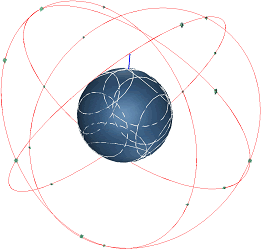 Through the network of satellites that orbit the track orbital, this system is possible to deliver sound quality with a better effect without resonance. but also how, satellite Geo is still better and more suitable for transmission that has a wide spectrum such as television.
Through the network of satellites that orbit the track orbital, this system is possible to deliver sound quality with a better effect without resonance. but also how, satellite Geo is still better and more suitable for transmission that has a wide spectrum such as television.
Adrian's blog will do something with the best information that provides useful and popular, and find solutions on adrian's blog. My blogging in adrian's blog about many things such as technology development, research, opinions etc...
Friday, September 12, 2008
Medium Earth Orbit (MEO)
Telecommunication services and the demands of the mobile cellular systems and wireless. From here appear discourse satellite Medium Earth orbit (MEO) and LEO [Low Earth Orbit]. Unlike satellite Geo, which sit on the distance of 22,300 miles above the Earth, LEO satellites gather in the distance about 400 miles only, and the MEO orbit 10,000 km distance between the 36.000 Km. Distance lower, need more advanced technology, allows people to communicate across the world with a mobile phone pocket size. Because of LEO and MEO satellites close together, a network coverage is needed to create the equivalent satellite Geo.
 Through the network of satellites that orbit the track orbital, this system is possible to deliver sound quality with a better effect without resonance. but also how, satellite Geo is still better and more suitable for transmission that has a wide spectrum such as television.
Through the network of satellites that orbit the track orbital, this system is possible to deliver sound quality with a better effect without resonance. but also how, satellite Geo is still better and more suitable for transmission that has a wide spectrum such as television.
 Through the network of satellites that orbit the track orbital, this system is possible to deliver sound quality with a better effect without resonance. but also how, satellite Geo is still better and more suitable for transmission that has a wide spectrum such as television.
Through the network of satellites that orbit the track orbital, this system is possible to deliver sound quality with a better effect without resonance. but also how, satellite Geo is still better and more suitable for transmission that has a wide spectrum such as television.
Tuesday, September 9, 2008
Low Earth orbit-LEO
Low orbit is an orbit around the Earth between the atmosphere and the Van Allen radiation belt, with a low inclination angle. These limits are not defined exactly, but usually under 1,500 km above the surface of Earth. This orbit is usually located under the intermediate circular orbit (ICO) and far below the geostationary orbit. Orbital lower from here is not stable and will fall quickly because of the atmosphere of friction. A higher orbit from the orbital This is the subject of electronic failure early because of strong radiation and collecting cargo. Orbital inclination angle with a higher usually called a polar orbit. Objects in low Earth orbit to meet
 the gas atmosphere in the thermosphere (about 80-500 km above) or exosphere (approximately 500 km above), depending on the altitude orbit. Most of the flight space probe has been in LEO, including all the various space shuttle and space station mission; one exception is the suborbital test flights as early Mercury Project and the SpaceShipOne flight (which did not achieve the intended LEO), and Project Apollo missions to the Moon (which passes LEO ).
the gas atmosphere in the thermosphere (about 80-500 km above) or exosphere (approximately 500 km above), depending on the altitude orbit. Most of the flight space probe has been in LEO, including all the various space shuttle and space station mission; one exception is the suborbital test flights as early Mercury Project and the SpaceShipOne flight (which did not achieve the intended LEO), and Project Apollo missions to the Moon (which passes LEO ).
 the gas atmosphere in the thermosphere (about 80-500 km above) or exosphere (approximately 500 km above), depending on the altitude orbit. Most of the flight space probe has been in LEO, including all the various space shuttle and space station mission; one exception is the suborbital test flights as early Mercury Project and the SpaceShipOne flight (which did not achieve the intended LEO), and Project Apollo missions to the Moon (which passes LEO ).
the gas atmosphere in the thermosphere (about 80-500 km above) or exosphere (approximately 500 km above), depending on the altitude orbit. Most of the flight space probe has been in LEO, including all the various space shuttle and space station mission; one exception is the suborbital test flights as early Mercury Project and the SpaceShipOne flight (which did not achieve the intended LEO), and Project Apollo missions to the Moon (which passes LEO ).
Subscribe to:
Comments (Atom)